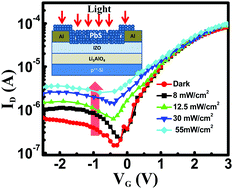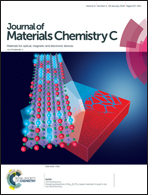Solution processed Li5AlO4 dielectric for low voltage transistor fabrication and its application in metal oxide/quantum dot heterojunction phototransistors†
Abstract
Li5AlO4, a well-known material for solid state electrolyte application, has never been considered hitherto as a gate dielectric of metal oxide thin film transistors (TFTs). Here we demonstrate the salient features of Li5AlO4 as a gate dielectric outperforming the conventional inorganic dielectrics used in TFTs. The high dielectric constant (k) of this insulator has been achieved by utilizing the improved capacitance contributed by mobile lithium ions (Li+) within the dielectric film. We have synthesized this dielectric via a cost-effective sol–gel method followed by a low-temperature annealing process yielding three phases such as amorphous-Li5AlO4 (a-Li5AlO4), α-Li5AlO4, and β-Li5AlO4 under different annealing conditions. Optimized TFTs fabricated with all of these three phases of Li5AlO4 on top of a highly doped silicon (p++-Si) wafer and a solution processed semiconducting layer of indium zinc oxide (IZO) exhibit an excellent TFT performance at different operating voltages. Among these three different types of TFTs, the device with an α-Li5AlO4 gate dielectric annealed at 500 °C shows the best device performance with an on/off ratio of 5 × 104 and an electron mobility of 21.4 ± 2.16 cm2 V−1 s−1. In addition, this device requires the least drain voltage (<2 V) to reach the saturation drain current due to the higher Li+ mobility of the α-Li5AlO4 gate dielectric. This TFT performance on the p++-Si substrate is superior to that of a previously reported device with a sodium beta-alumina (SBA) gate dielectric, where the percentage of mobile ions within the dielectric material was comparatively much lower. Moreover, this dielectric requires ∼300 °C lower annealing temperature compared to the SBA dielectric. A metal oxide/quantum dot heterojunction phototransistor was fabricated by coating an IZO TFT with colloidal lead sulphide (PbS) quantum dots that shows a responsivity and a response time of 4.5 × 10−4 A W−1 and 2.2 s respectively.



 Please wait while we load your content...
Please wait while we load your content...